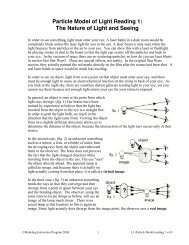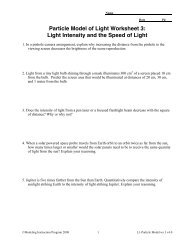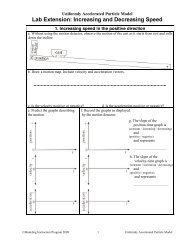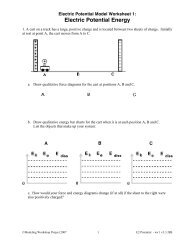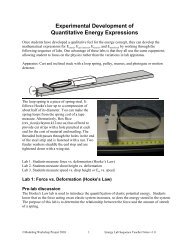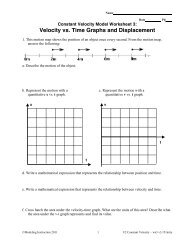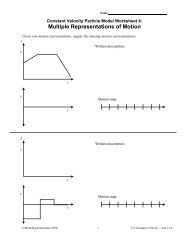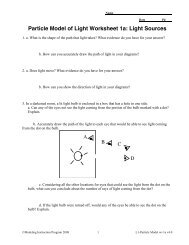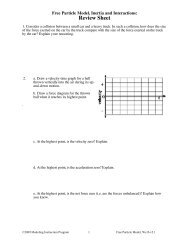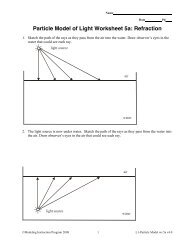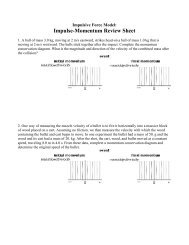Worksheet 2 - Modeling Physics
Worksheet 2 - Modeling Physics
Worksheet 2 - Modeling Physics
Create successful ePaper yourself
Turn your PDF publications into a flip-book with our unique Google optimized e-Paper software.
Name<br />
Particle Models in Two Dimensions <strong>Worksheet</strong> 2:<br />
Horizonally Launched Projectiles<br />
1. Given the following situation of a marble in motion on a rail with negligible F friction :<br />
a. Sketch a motion map showing the motion of the marble after it leaves the rail, using the<br />
grid to help you carefully locate the marble’s positions. Show both horizontal and vertical<br />
velocity vectors on each dot.<br />
h = 1.5 m<br />
b. Sketch and label force diagrams for the marble both when it is on the rail and off the rail.<br />
Describe the horizontal and vertical motion of the ball in each case.<br />
c. Once the ball leaves the table, calculate how long it will take for the ball to hit the floor.<br />
d. In the time you have calculated in part c, how far will the ball travel horizontally before<br />
hitting the floor<br />
e. Suppose the table was doubled in height to 3.0 m. Determine the horizontal range of the<br />
marble as it falls to the floor. What effect does doubling the height have on range of the<br />
marble What other factors affect the range of the sphere<br />
©<strong>Modeling</strong> Instruction 2010 1 U6 2D Motion - ws 2 v3.0
2. A student finds that it takes 0.20s for a ball to pass through photogates placed 30 cm apart on a<br />
level ramp. The end of the ramp is 92 cm above the floor. Where could a coin be placed so that the<br />
ball directly strikes the coin on impact with the ground<br />
3. Suppose now that the same ball, released from the same ramp (92 cm high) struck a coin on the<br />
floor placed 25 cm from the end of the ramp.<br />
a. What was the ball's horizontal velocity<br />
b. How long did it take for the ball to pass through the photogates<br />
©<strong>Modeling</strong> Instruction 2010 2 U6 2D Motion - ws 2 v3.0
In all the problems below, draw a diagram to represent the situation. Identify the knowns<br />
and unknowns and label clearly.<br />
4. The movie "The Gods Must Be Crazy" begins with a pilot dropping a bottle out of an airplane. A<br />
surprised native below, who thinks it is a message from the gods, recovers it. If the plane from<br />
which the bottle was dropped was flying at a height of 500m, and the bottle lands 400m horizontally<br />
from the initial dropping point, how fast was the plane flying when the bottle was released<br />
5. Suppose that an airplane flying 60 m/s, at a height of 300m, dropped a sack of flour. How far<br />
from the point of release would the sack have traveled when it struck the ground Where will the<br />
plane be in relation to the sack when the sack hits the ground Illustrate your answer carefully using<br />
the grid provided.<br />
6. In many locations, old abandoned stone quarries have become filled with water once excavating<br />
has been completed. While standing on a quarry wall, a boy tosses a piece of granite into the water<br />
below. If he throws the rock horizontally with a velocity of 3.0 m/s, and it strikes the water 4.5 m<br />
away, how high above the water is the wall<br />
©<strong>Modeling</strong> Instruction 2010 3 U6 2D Motion - ws 2 v3.0
7. Tad drops a cherry pit out the car window 1.0 m above the ground while traveling down the road<br />
at 18 m/s. How far, horizontally, from the initial dropping point will the pit hit the ground If the car<br />
continues to travel at the same speed, where will the car be in relation to the pit when it lands<br />
8. A kickoff sends a football with an initial velocity of 25 m/s at an angle of 50 degrees above<br />
horizontal.<br />
a. Find the x and y-components of the velocity<br />
b. Find the time the ball is in the air<br />
c. Find the horizontal distance the ball travels before hitting the ground.<br />
d. Find the maximum height of the ball.<br />
©<strong>Modeling</strong> Instruction 2010 4 U6 2D Motion - ws 2 v3.0




